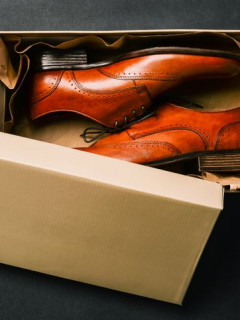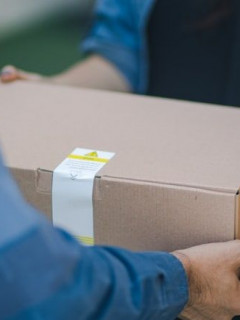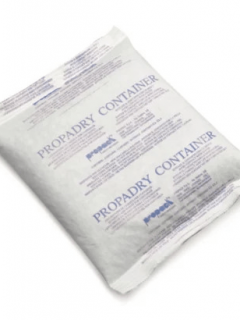Various types of film dominate today’s packaging, transport and e-commerce industries – it is difficult to imagine packaging products without them. Some of the most popular materials are stretch film and shrink film. Each has different properties and applications. What similarities and differences do they exhibit – especially in terms of their intended use?
What is shrink film?
Shrinkfilm is a heat-sealable, slippery material made from a variety of polymers, such as LDPE (low density polyethylene). What distinguishes it from other similar products is its heat shrinkability – the ability to shrink when exposed to relatively low temperatures (by up to 2/3 of its original size). The reduction in volume is linked to the shape-fitting of the item being packaged.
Heat-shrinkable film protects goods against contamination, moisture, mechanical damage and UV radiation, among others. It does not allow the packaged goods to move during transport.
Properties of heat-shrinkable film
Heat-shrinkable film has unique properties. In addition to its heat-shrinkability, which has already been mentioned, it is distinguished by its excellent strength and resistance to UV radiation and mechanical damage (stretching, punctures, tears). This versatile, low-cost, slippery product can be used to pack irregularly shaped, sharp-edged goods. Shrink film will fit a variety of sizes (both small and large items). It can cover not only individual goods, but also entire batches, pallets of cargo.
The shrink film is tasteless and odourless (suitable for food packaging). It has high transparency and gloss. It is useful where the aesthetics of the packaging play an extremely important role. It is sometimes possible to purchase coloured or personalised shrink films (printed with a logo or company name, graphics, a catchy slogan).
Types of shrink film
Shrink film is divided into several sub-types. These include heat-shrinkable tapes (rolls), as well as heat-shrinkable sleeves, half-sleeves and hoods.
The former are popularly used for the packaging of bottles in shrink-wraps. Heat-shrinkable tapes are particularly popular in the food, chemical and automotive industries. Sleeves take the form of a film folded in half and then sealed tightly along both sides. It is a material for the production of bags, pouches. Half-sleeves resemble their predecessors, but unlike them, they have a slit along one side edge (the material can be unfolded in a single layer). They are suitable for packing loose or bulky products.
Hoods (transparent or coloured) are the basis for protecting goods on pallets – and in this respect the biggest competitor of stretch film. They can protect loads from slipping off the pallet during transport, from being seen by unauthorised persons and from damage caused by adverse weather conditions. Shrink hoods have a length well suited to the anticipated height of the goods on the pallet, reaching up to 10 metres in circumference.
What is stretch film?
Stretchfilm is a flexible, highly stretchable packaging material. It reaches various widths, colours, degrees of stretch and transparency. It is produced from plastics (polypropylene and polyethylene) by blow moulding or machine casting. The product shows considerable strength, high adhesion, as well as high resistance to mechanical and chemical damage, contamination, moisture.
Types of stretch film
Stretchfilm can be divided in various ways. Here we will present a breakdown in terms of the purpose of the product. We divide stretch film into those intended for manual packaging (e.g. of loads on pallets) or machine packaging (the need to use wrapping machines).
An interesting type is pre-stretch film, which does not stretch during application – this ensures the stabilisation of the load being protected. Also worth mentioning is jumbo stretch film, intended for further processing into the manual type.
When making a choice, a common dilemma is: which colour of stretch film to choose? Much depends on the industry – the most popular choice is black and transparent. Coloured stretch films have an analogous purpose to black (to protect the pallet, shipment from the sight of unwanted people).
Application of heat-shrinkable film and stretch film – basic differences
Heat-shrinkable film and stretch film have similar applications (packaging, covering goods), but their different properties make them used for different purposes. A common use is in the commercial, logistics sector – both materials are used by manufacturing and industrial companies, transport companies, online shops. The films cover wooden pallets (less often plastic pallets) with loads, preventing the contents from changing position, falling out.
The main difference is in the properties. You don’t have to think long about how to use stretch film versus shrink film. The answer is simple. Flexible stretch film perfectly covers all the nooks and crannies of the pallet, but does not shrink – it is heat-shrinkable film which, as a result of the right temperature, changes its volume and adheres to the surface of the packed item.
Both packaging materials are also suitable for food packaging (e.g. meat, confectionery and bakery products, fruit and vegetables, cheese). Heat-shrinkable film – non-toxic, odourless and safe for food contact – is used for packaging those foodstuffs that spoil extremely quickly, e.g. trays of vegetables or meat, often seen in hypermarkets. Airtight packaging extends their shelf life.
Stretch film (thin, affordable) also guarantees that the product is completely airtight (no contamination). It is useful for freezing food, e.g. portioning fruit and vegetables. Frozen stretch film retains a flexible and strong structure, creating excellent conditions for long-term food storage.
All similarities, you might say – but where are the differences? In short, shrink film increases the shelf life of food even further. In practice, however, stretch film is used more often.
Application of shrink film – other examples
Shrink filmis often chosen by companies involved in packaging products made of delicate materials, e.g. glass, porcelain, cardboard. It can become decorative packaging for cosmetics, candles, toys.
Stretch film applications – other examples
Stretchfilm is useful during renovations – to protect furniture against dust, paint and dirt. In construction, it can be used to temporarily close window and door openings. It is used as a covering (roof, walls) for large and small greenhouses – helping to maintain the right microclimate in such places. It is commonly used for cosmetic procedures, in particular for anti-cellulite packs and face masks (it also enhances the thermal effect and makes the active substances from the masks penetrate deeper into the skin’s surface).
Last but not least, stretch film can also be used at home, e.g. for storing clothing, seasonal shoes, suitcases, travel accessories, tools, children’s toys or – here the larger sizes – building materials. It guarantees complete safety.













